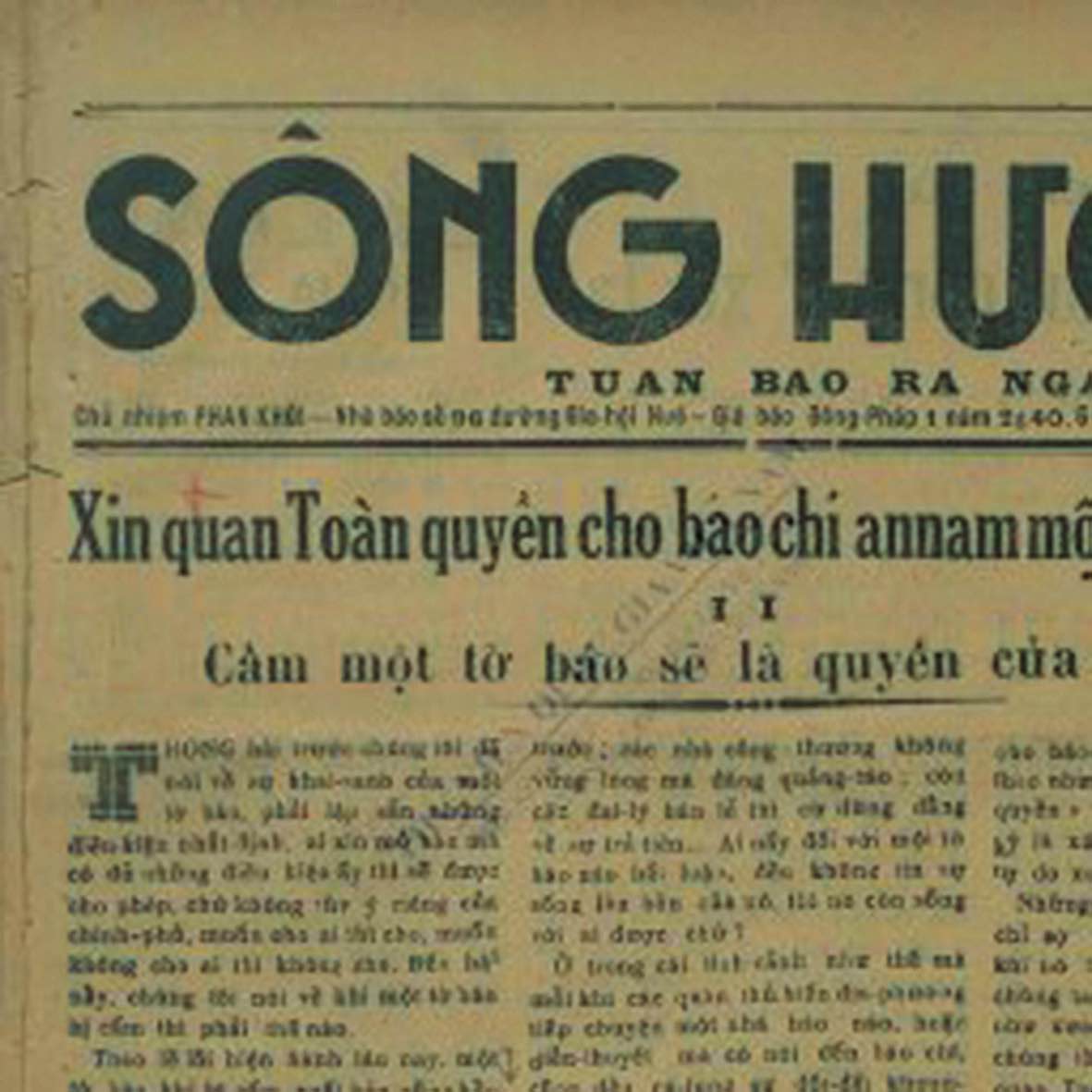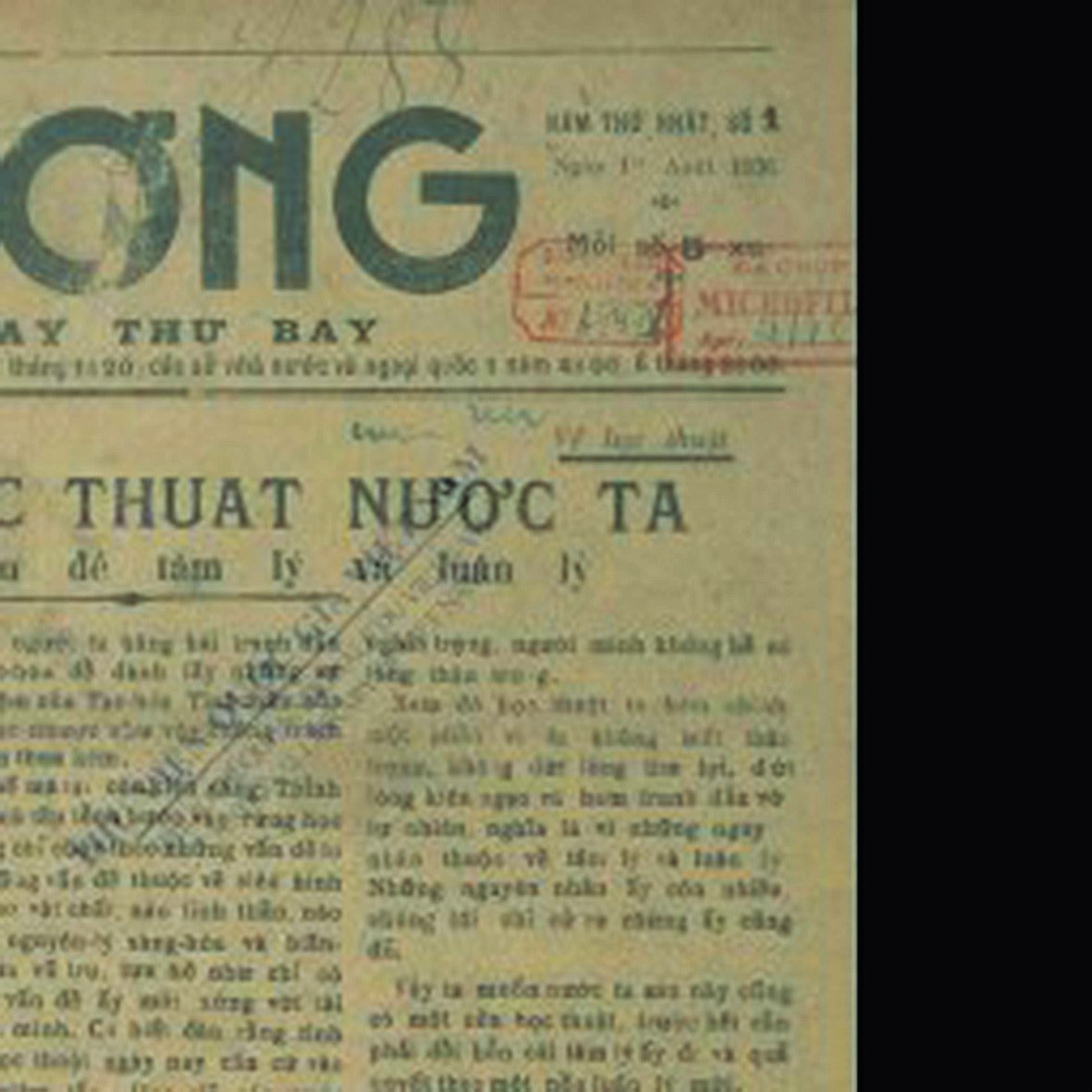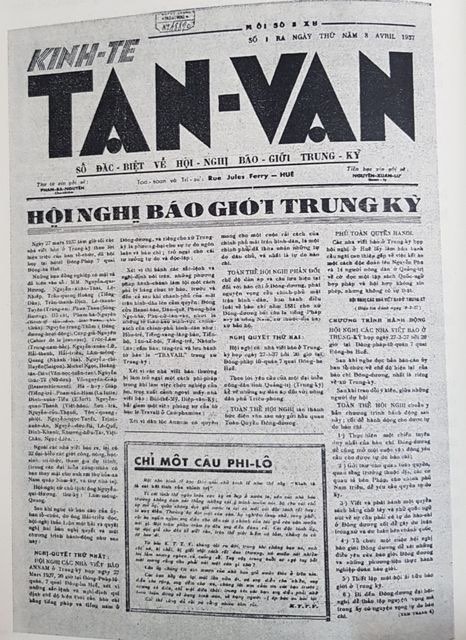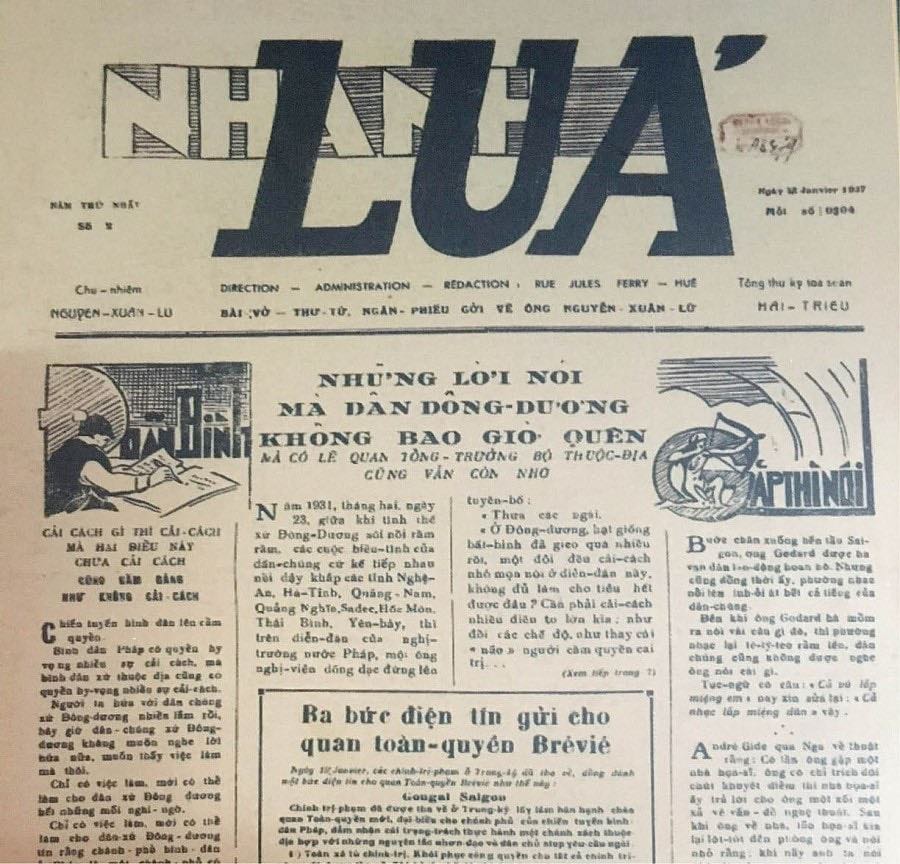Under the direct leadership of the Central Party Committee, the struggle movement of the people of the Central region took place on all fronts, in which revolutionary press became a pioneering force in the struggle for people's livelihood and democracy.
Chinese revolutionary press during the period of 1936-1939
In response to the loose policies of the French colonialists, especially in the press, the Central Committee of the Indochinese Communist Party issued a document on March 20, 1937, stating: "Party committees at all levels must encourage those who feel sorry and ask the government to allow the publishing of public newspapers" and "P Party committees should take some comrades who can write flowing documents (French additions or French characters) to share and write articles in public newspapers to attract public opinion".
On that basis, many revolutionary newspapers in the Central region were born such as: Nhanh Hoa, Song Huong Duong Nhan, Dan, Dan Chu, Dan Vuong, Dong Thanh Kinh, Lan, Tien Toi. Some local Party cells also issue their own newspapers such as Tia Sang newspaper of Thanh Hoa Provincial Party Committee, Dan Khong newspaper of Nghe An Provincial Party Committee, Chi Do newspaper of Nghe An Provincial Party Committee, Tranh Dau newspaper of Quang Tri Provincial Party Committee, Do Magazine, of Quang Ngai Provincial Party Committee.


Trung Ky is both under the protection of the colonial government and under the control of the feudal government, so many newspapers only existed for a short time and the printing of newspapers had to be done elsewhere. For example, Dan newspaper published 17 issues in 4 months (July to October 1938) and was closed, Dan Tien newspaper was born immediately afterwards and when Dan Tien was banned, Dan Muon newspaper was born. These newspapers are edited in Trung Ky but most of them are printed in Hanoi or Saigon.
Despite strict management, the number of newspapers published in Trung Ky is quite large. In particular, Dan newspaper, launched to readers on July 6, 1938, is the newspaper with the most readers with a printed circulation of up to 6,000 copies per issue. Nhanh Hoa Newspaper with the most numbers also issued 5,000 numbers. The reason why revolutionary journalism in the Central region has developed so strongly is because there is a team of authors who are brave, sharp and have extremely sharp pen names such as Hai Trieu, Phan Dang Luu, Nguyen Xuan Lu...
Revolutionary press - the voice of freedom and democracy
One of the outstanding features of the Chinese revolutionary press in this period is its strong demand for freedom of speech, the right to organize and establish associations - basic rights in a democratic society. Newspapers such as Dan, Dan Den, Dan muon, Nhanh Hoa have become forums reflecting the voices of the working masses. To make the general public and workers in particular understand the basic issues of democratic freedom, the Labor Law, and the Dan newspaper with the section "People ask; People answer" regularly ask questions and then answer thoroughly so that the people understand: "People answer for democratic freedom" (den papers 3, July 22, 1938. Duong Phuoc Thu, 2018,); "People ask: ... what is the minimum wage" (Dan No. 2 Newspaper, July 13, 1938).
At the same time, revolutionary press also published many articles requesting the Southern Dynasty government to exercise democratic freedoms for the people, including the right to establish trade unions and friendship. Thanks to that, charity and mutual support associations were established in almost all of the Central Highlands provinces. Journalists have closely followed the contents of the policies issued by the government, thereby flexibly applying them to demand the rights of the people. This work has great significance in encouraging the fighting spirit for freedom of organization - an extremely essential thing for the workers and laborers' movement at that time.
The Chinese revolutionary press as well as the whole country in general do not stand aside but play the role of a companion in the fight against the workers' movement across the country. Every strike, every demand for improving life, the press promptly reflects, both to spread the fighting spirit and to apply social and international pressure to reduce the oppression from the owners and the government. For example, Nhanh Luoi Newspaper recorded the case of beating and injuring people at Nam Dinh fiber factory: "The fact that Chu Thi Mau was recently taken to the Hanoi Supreme Court with a rock and belly by Surveillant Georges Malit a few days ago has just happened to something new... Another 16-year-old child named Bui Van Van has lost his parents. Due to working at night for many hours, it was a bit sluggish, and the name of the bridge Nghe had reached the point of danger of flooding". "It's been bleeding, bleeding, and I don't know how to live or die yet"...

Thanks to timely reflection, Trung Ky people have clearly seen the brutal oppression of colonial rule against workers and farmers across the country.
At the same time, newspapers also focus on setting examples of successful struggles to motivate other movements. Building the image of a resilient struggling worker has contributed to spreading patriotism and class awareness, affirming the pioneering role of the working class in the national - democratic revolution.
A hot spot in the Chinese revolutionary press is the issue of turnover tax. Due to the characteristics of being an area subject to two levels of oppression - the French colonial government and the Nguyen Dynasty, Trung Ky farmers had to bear many unreasonable taxes, making their already poor life even more miserable.
Newspapers such as Dan, Dan Den and Dan want to continuously speak out against unfair taxes. The content of the articles often emphasizes the unreasonableness and exploitation of the government, creating strong pressure in public opinion. Not only stopping at the press, under the leadership of the Trung Ky Fourth Party Committee, many rallies and protests were also organized, coordinating propaganda and practical actions.
The obvious consequence is that the government's corporate tax increase project has been rejected, and the land tax project has not been approved. Press public opinion has contributed significantly to this victory, demonstrating the power of journalism when attached to the mass movement.
At the same time, the investigation, learning and reporting news about the lives of the masses and revolutionary newspapers in the Central Highlands has made all classes and classes in society better understand each other's lives. From there, classes can easily find a common voice, easily create solidarity in fighting against common enemy.
Not only reflecting reality, Trung Ky press is also a tool to organize movements, typically playing a role in the congress's Indochina campaign. The Rice Branch Newspaper from No. 5 (February 12, 1937) to No. 8 (March 5, 1937) has continuously reported and mobilized people to send recommendations and organize a reception for the All-powerful Godard. The results were impressive: Tens of thousands of people took to the streets in many provinces such as Hue, Phu Loc, Thua Thien, Nghe An... despite no specific leadership organizations. The press has been a bridge between the masses and political goals, contributing to turning the event welcoming host Godard into a profound mass movement of political significance.
Concretizing the Party's guidelines in the early days
The Party's policies have always been closely followed by revolutionary newspapers in the Central region. However, like revolutionary newspapers in the North at this time, in order not to be made difficult by the government, the Party's guidelines are often concretized by newspapers with articles outlining specific steps for the masses to follow.
For example, to concretize the Party's policy on conducting the congress of the Indochina movement, the Rice Branch newspaper published an article: "Going to the next congress of the Indochina and the reception of the investigation committee of the local ministry ( thing that needs to be done urgently)" (Rice Branch Newspaper No. 3, January 29, 1937). In particular, the article clearly states specific steps for the masses to grasp in the coming time.
Or to concretize the policy of fighting for union freedom, Trung Ky revolutionary newspapers published many articles to clarify this issue such as: "Heroes, workers of Trung Ky, Bac Ky, Cao Mien and Ai Lao" (Song Huong, tuc so 2 dated June 26, 1937). The article quoted the call of the Southern Federation of Labor's Wise Committee "We call on our brothers and sisters in the Central, Northern, Southern and Asian regions to quickly respond to us, to establish Wise Union Committees in factories, plantations, streets, mines... Establish Wise Union Committees of each country, together with us, exchange opinions to easily reach the National General Confederation of Labor and unify".
From this creative approach, the Party's policies get closer to the masses. At the same time, from concretizing the Party's policies, the masses will understand and implement more easily.
Suggestions for today
In general, compared to the previous period, the Chinese revolutionary press in the period of 1936-1939 has had a strong development in both quantity and efficiency for the revolutionary movement in practice. To avoid government control, communists have used a variety of types of press (prints, handwritten newspapers, paper newspapers), many methods of press release (buying existing newspapers, asking for permission to press, editing in one country but printing and distributing in another country). This creativity has brought about certain effectiveness in resisting the strict censorship of the French colonial government and the Hue royal court. The communists here are always aware of the power of the press, so when a newspaper is banned, they immediately launch another newspaper to continue the struggle. The persistent and flexible struggle of the Chinese revolutionary press during the 1936-1939 period contributed to certain practical victories, such as winning the election to the Chinese House of Representatives, preventing unreasonable tax increase plans and strongly supporting the popular and democratic movements.

From the practical revolutionary press activities in the Central region during the 1939. period, many valuable lessons can be drawn for Vietnamese journalism in the current context.
First of all, the spirit of commitment and companionship with the people, expressed through the press reflecting the lives of workers, farmers, and struggling for people's livelihood and democracy, is still the core value that modern journalism needs to inherit. In the period of innovation and integration, issues such as rich-poor differentiation, corruption, environment, workers' rights... require the press to not only report but also play the role of social supervision, speaking promptly for the benefit of the public.
Secondly, the Chinese revolutionary press has shown political mettle and sharp intelligence when using appropriate language, form and content to overcome censorship and convey revolutionary messages. This requires today's press to constantly innovate its approach and take advantage of modern communication technology, especially in the strongly developing social network environment, to improve the effectiveness of policy communication, orient public opinion and protect the Party's ideological foundation.
Third, modern journalism needs to learn from the spirit of solidarity and unity of previous revolutionary newspapers. In the context of fierce information competition and rapid development of social networks, press agencies need to share data, coordinate in criticizing misinformation, and at the same time build the collective reputation of revolutionary, methodical and professional journalism.
Finally, if the Chinese revolutionary press has known to turn pencils into weapons to fight against injustice and demand freedom, then today's press must continue to play the role of one of the four important "power" in modern society: criticizing, discovering, supervising and proposing policies, within the framework of law, ethics and for the benefit of the people and nation.
By inheriting traditional values and innovating in methods, modern Vietnamese press can continue to affirm its pioneering role in the cause of building and defending the Fatherland, as the Chinese revolutionary press did in the difficult but also ideal years of the 1930s.











